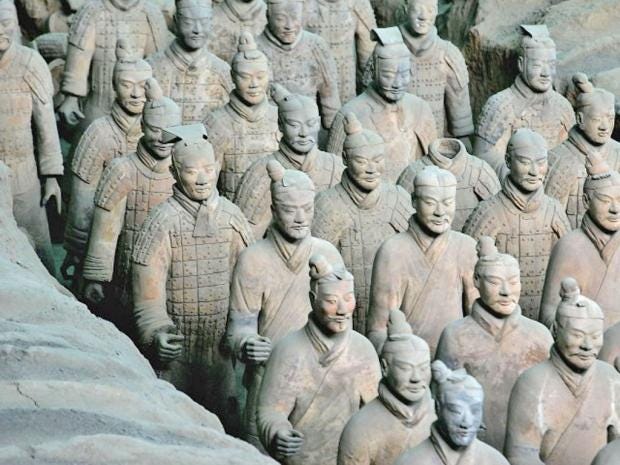Roman coins in Japan, Chinese remains from Roman Britain, Roman carved head in Mexico...all part of what we've been calling "lost history" for decades.
But we were dopes. Fantasists -or worse. Now whose laughing? Greeks in China....
Ancient Greeks may have built China's famous Terracotta Army – 1,500 years before Marco Polo
'We have discovered something more important even than the Terracotta Army,' says Chinese archaeologist

Ancient Greeks artists could
have travelled to China
The startling claim is based
on two key pieces of evidence: European DNA discovered at sites in China
Before this time, depictions
of humans in China
But 8,000 extraordinarily
life-like terracotta figures were found buried close to the massive tomb of China
The First Emperor's
Terracotta Army recruited outside China
The theory – outlined in a
documentary, The Greatest Tomb on Earth: Secrets of Ancient China, to be shown
on BBC Two on Sunday – is that Shi Huang and Chinese artists may have been
influenced by the arrival of Greek statues in central Asia in the century
following Alexander the Great, who led an army into India
But the researchers also
speculated that Greek artists could have been present when the soldiers of the
Terracotta Army were made.
One of the team, Professor
Lukas Nickel, chair of Asian art history at Vienna University
Other evidence of connections
to Greece Egypt
There was a breakthrough in
sculpture particularly in ancient Athens
Previously, human figures
have been stiff and stylised representations, but the figures carved on the
Parthenon temple were so life-like it appeared the artists had turned stone
into flesh.
Their work has rarely been
bettered – the techniques used were largely forgotten until they were revived
in the Renaissance when artists carved statues in the Ancient Greek style, most
notably Michelangelo’s David.
Dr Li Xiuzhen, senior
archaeologist at the tomb’s museum, agreed that it appeared Ancient Greece had
influenced events in China
“We now have evidence that
close contact existed between the First Emperor’s China
and the West before the formal opening of the Silk Road ,”
the expert said.
“This is far earlier than we
formerly thought.
“We now think the Terracotta
Army, the acrobats and the bronze sculptures found on site have been inspired
by ancient Greek sculptures and art.”
And Professor Zhang Weixing,
lead archaeologist at the tomb site, said: “The archaeological work undertaken
here recently is more important than anything in the last 40 years.
“By systematically examining
the First Emperor’s main tomb and subsidiary burials we have discovered
something more important even than the Terracotta Army.”
The mitochondrial DNA samples
revealed Europeans had settled down in China
Hamish Mykura, of the
National Geographic Channel, which made the documentary with the BBC, said:
“The scope of these archaeological finds and what they mean for world history
are astonishing.
“The new revelation that two
of the world’s ancient super powers may have been in contact is a vital
reminder today of the need for intercultural communication on a global scale.”
And BBC presenter Dan Snow
said: “I hope audiences will find the new evidence as astonishing and
thought-provoking as I did.
“It is extraordinary to think
that history as we know it is changeable.”

No comments:
Post a Comment